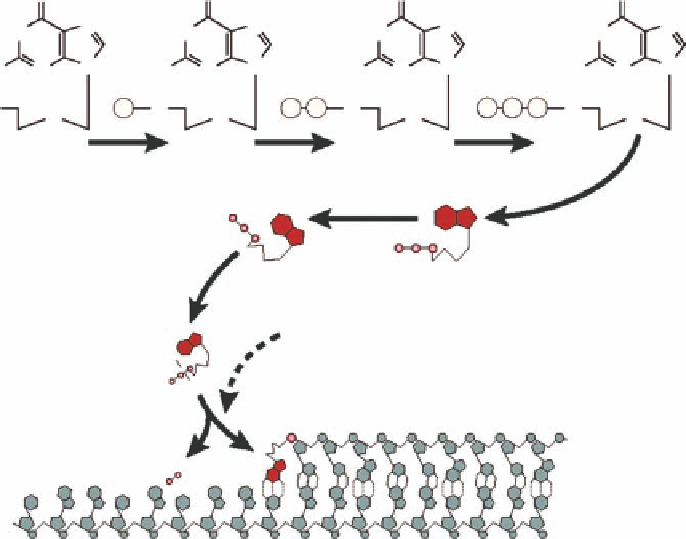Biomedical Engineering Reference
In-Depth Information
ACV
ACV-MP
ACV-DP
O
ACV-TP
O
O
O
N
N
N
N
HN
HN
HN
HN
N
N
N
N
H
2
N
N
H
2
N
N
H
2
N
N
H
2
N
N
O
O
HO
P
O
P
P
P
P
P
O
O
O
O
HSV-1 TK
GMP kinase
NDP kinase
Viral DNA
polymerase
DNA
DNA
FIGURE 24.12
Mechanism of antiviral action of acyclovir (ACV). ACV targets viral DNA polymerases,
such as the herpesvirus (HSV) DNA polymerase. Before it can interact with viral DNA synthesis, it needs to
be phosphorylated intracellularly, in three steps, to the triphosphate form. The i rst phosphorylation step is
ensured by the HSV-encoded thymidine kinase (TK), and is therefore coni ned to virus-infected cells. (After
De Clercq, E.,
Nat. Rev. Drug Discov
., 1, 13, 2002.)
Activity spectrum
: HSV-1, HSV-2, and VZV.
Mechanism of action
: Serves as oral prodrug of penciclovir (to which it is converted by hydrolysis
of the two acetyl groups and oxidation at the 6-position), then acts as described for penciclovir.
Principal indication(s)
: HSV-1, HSV-2, and VZV infections.
Administered
: Orally at 750 mg/day (250 mg tablet every 8 h, three times a day), or 1500 mg/day
(500 mg every 8 h).
24.4.1.5 Idoxuridine
Structure
(Figure 24.11): 5-Iodo-2
′
-deoxyuridine (IDU, IUdR), Herpid
®
, Stoxil
®
, Idoxene
®
,
Virudox
®
, etc.
Activity spectrum
: HSV-1, HSV-2, and VZV.
Mechanism of action
: Incorporated into (viral/cellular) DNA, following intracellular phosphoryla-
tion to IDU 5
-triphosphate (in virus-infected and uninfected cells).
Principal indication(s)
: HSV keratitis.
Administered
: Topically as eyedrops (0.1%) or ophthalmic cream.
′
24.4.1.6 Trifl uridine
Structure
(Figure 24.11): 5-Tril uoromethyl-2
′
-deoxyuridine, tril uorothymidine (TFT), Viroptic
®
.

